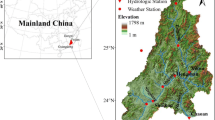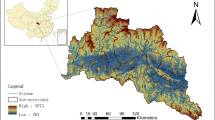Abstract
The source and sink landscape patterns refer to landscape types or units that can either promote positive evolvement of non-point source (NPS) pollution process, or can prevent/defer the ecological process, respectively. Therefore, the role of a catchment landscape pattern in nutrient losses can be identified based on the spatial arrangement of source and sink landscapes. To reveal the relations between landscape spatial characteristics and NPS pollution in small catchment, a case study was carried out in a Wangjiagou small catchment of the Three Gorges Reservoir Region (TGRR), China. Google earth imagery for 2015 were processed and used to differentiate source and sink landscape types, and six subcatchments were selected as sample regions for monitoring nitrogen and phosphorus nutrients. Relative elevation, slope gradient and relative flow length was used to construct the Lorenz curves of different source and sink landscape types in the catchment, in order to assess the source and sink landscape spatial characteristics. By calculating the location-weighted landscape indices of each subcatchment and total catchment, the landscape spatial load characteristics affecting the NPS pollution was identified, with a further Pearson correlation analysis for location-weighted landscape indices and nitrogen-phosphorus monitoring indicators. The analysis of Lorenz curve has revealed that the obtained distribution trend of Lorenz curve and curve area quantified well the spatial characteristics of source and sink landscape pattern related to the relative elevation, slope gradient and relative flow length in small catchment. Results of Pearson correction analysis indicated that location-weighted landscape index (LWLI) combining of terrain and landscape type factor did better in reflecting the status of nitrogen and phosphorus loss than the indices related to relative elevation, slope gradient and relative flow length.
Similar content being viewed by others
References
Baker ME, Weller DE, Jordan TE (2006) Improved methods for quantifying potential nutrient interception by riparian buffers. Landscape Ecology 21(8): 1327–1345. https://doi.org/10.1007/s10980-006-0020-0
Basnyat P, Teeter LD, Flynn KM, et al. (1999) Relationships between landscape characteristics and non-point source pollution inputs to coastal estuaries. Environmental Management 23(4): 539–549. https://doi.org/10.1007/s0026 79900208
Chen AL, Zhao XF, Yao L, et al. (2016a) Application of a new integrated landscape index to predict potential urban heat islands. Ecological Indicators 69: 828–835. https://doi.org/10.1016/j.ecolind.2016.05.045
Chen CL, Gao M, Xie DT, et al. (2016b) Spatial and temporal variations in non-point source losses of nitrogen and phosphorus in a small agricultural catchment in the Three Gorges Region. Environ. Environmental Monitoring & Assessment 188(4):1–15. https://doi.org/10.1007/s10661-016-5260-0
Chen LD, Fu BJ, Zhao WW (2008) Source-sink landscape theory and its ecological significance. Frontiers in Biology 3(2): 131–136. https://doi.org/10.1007/s11515-008-0026-x
Chen LD, Tian HY, Fu BJ, et al. (2009) Development of a new index for integrating landscape patterns with ecological processes at watershed scale. Chinese Geographical Science 19(1): 37–45. https://doi.org/10.1007/s11769-009-0037-9
Defourny P, Schouten L, Bartalev S, et al. (2009) Accuracy Assessment of a 300M Global Land Cover Map: the GlobCover Experience. In 33rd International Symposium on Remote Sensing of Environment, Sustaining the Millennium Development Goals, 1–5.
Dindaroğlu T, Reis M, Akay AE, et al. (2015) Hydroecological approach for determining the width of riparian buffer zones for providing soil conservation and water quality. International Journal of Environment Science and Technology 12(1): 275–284. https://doi.org/10.1007/s13762-013-0444-4
Gergel SE (2005) Spatial and non-spatial factors: When do they affect landscape indicators of watershed loading? Landscape Ecology 20(2): 177–189. https://doi.org/10.1007/s10980-004-2263-y
Gergel SE, Turner MG, Miller JR, et al. (2002) Landscape indicators of human impacts to riverine systems. Aquatic Sciences 64(2): 118–128. https://doi.org/10.1007/s00027-002-8060-2
Ierodiaconou D, Laurenson L, Leblanca M, et al. (2005) The consequences of land use change on nutrient exports: a regional scale assessment in south-west Victoria, Australia. Journal of Environmental Management 74(4): 305–316. https://doi.org/10.1016/j.jenvman.2004.09.010
Jiang MZ, Chen HY, Chen QH (2013) A method to analyze “source-sink” structure of non-point source pollution based on remote sensing technology. Environmental Pollution 182: 135–140. https://doi.org/10.1016/j.envpol.2013.07.006
Jiang MZ, Chen HY, Chen QH, et al. (2014) Study of landscape patterns of variation and optimization based on non-point source pollution control in an estuary. Marine Pollution Bulletin 87(1–2): 88–97. https://doi.org/10.1016/j.marpolbul. 2014.08.008
Johnes PJ (1996) Evaluation and management of the impact of land use change on the nitrogen and phosphorus load delivered to surface waters: the export coefficient modelling approach. Journal of Hydrology 183(3–4): 323–349. https://doi.org/10.1016/0022-1694(95)02951-6
Leitão AB, Miller J, Ahern J, et al. (2006) Measuring Landscapes: A Planner's Handbook. Island Press.
Ouyang W, Song KY, Wang XL, et al. (2014) Non-point source pollution dynamics under long-term agricultural development and relationship with landscape dynamics. Ecological Indicators 45(5): 579–589. https://doi.org/10.1016/j.ecolind. 2014.05.025
Pärn J, Pinay G, Mander Ü (2012) Indicators of nutrients traNPSort from agricultural catchments under temperate climate: A review. Ecological Indicators 22(22): 4–15. https://doi.org/10.1016/j.ecolind.2011.10.002
Potere D (2008) Horizontal positional accuracy of google Earth's high-resolution imagery archive. Sensors 8(12): 7973–7981. https://doi.org/10.3390/s8127973
Randhir TO, Tsvetkova O (2014) Spatiotemporal dynamics of landscape pattern and hydrologic process in watershed systems. Journal of Hydrology 404(1–2): 1–12. https://doi.org/10.1016/j.jhydrol.2011.03.019
Shan N, Ruan XH, Xu J, et al. (2014) Estimating the optimal width of buffer strip for nonpoint source pollution control in the Three Gorges Reservoir Area, China. Ecological Modelling 276: 51–63. https://doi.org/10.1016/j.ecolmodel.2013. 12.019
Shen ZY, Chen L, Hong Q, et al. (2013) Assessment of nitrogen and phosphorus loads and causal factors from different land use and soil types in the Three Gorges Reservoir Area. Science of the Total Environment 454–455: 383–392. https://doi.org/10.1016/j.scitotenv.2013.03.036
Shi YL (2015) The simulation of dynamic of nitrogen in small catchment of the Three Gorges Reservoir Region. Southwest University, Chongqing. (In Chinese)
Shi ZH, Cai CF, Ding SW, et al. (2004) Soil conservation planning at the small watershed level using RUSLE with GIS: a case study in the Three Gorge Area of China. Catena 55(1): 33–48. https://doi.org/10.1016/S0341-8162(03)00088-2
Tian YW, Huang ZL, Xiao WF (2010) Reductions in non-point source pollution through different management practices for an agricultural watershed in the Three Gorges Reservoir Area. Journal of Environmental Sciences 22(2): 184–191. https://doi.org/10.1016/S1001-0742(09)60091-7
Wang JL, Shao JA, Wang D, et al. (2016) Identification of the “source” and “sink” patterns influencing non-point source pollution in the Three Gorges Reservoir Area. Journal of Geographical Science 26(10): 1431–1448. https://dx.doi.org/10.1007/s11442-016-1336-6
Wang SM, He Q, Ai HN, et al. (2013) Pollutant concentrations and pollution loads in stormwater runoff from different land uses in Chongqing. Journal of Environmental Sciences 25(3): 502–510. https://doi.org/10.1016/S1001-0742(11)61032-2
Wang Y, Shen ZY, Niu JF, et al. (2009) Adsorption of phosphorus on sediments from the Three-Gorges Reservoir (China) and the relation with sediment compositions. Journal of Hazardous Materials 162(1): 92–98. https://doi.org/10.1016/j.jhazmat.2008.05.013
Wu ZP, Lin C, Su ZH, et al. (2016) Multiple landscape “sourcesink” structures for the monitoring and management of nonpoint source organic carbon loss in a peri-urban watershed. Catena 145: 15–29. https://doi.org/10.1016/j.catena. 2016.05.020
Xiao HG, Ji W (2007) Relating landscape characteristics to nonpoint source pollution in mine waste-located watersheds using geospatial techniques. Journal of Environmental Management 82(1): 111–119. https://doi.org/10.1016/j. jenvman.2005.12.009
Xu X, Tan Y, Yang GS (2013) Environmental impact assessments of the Three Gorges Project in China: Issues and interventions. Earth-Science Reviews 124(9): 115–125. https://doi.org/10.1016/j.earscirev.2013.05.007
Yang M, Li XZ, Hu YM, et al. (2012) Assessing effects of landscape pattern on sediment yield using sediment delivery distributed model and a landscape indicator. Ecological Indicators 22(17): 38–52. https://doi.org/10.1016/j.ecolind. 2011.08.023
Yeo IY, Gordon SI, Guldmann JM (2004) Optimizing patterns of land use to reduce peak runoff flow and nonpoint source pollution with an integrated hydrological and land use model. Earth Interact 8(6): 1–20. https://doi.org/10.1175/1087-3562(2004)008<0001:OPOLUT>2.0.CO;2
Zhang X, Cheng X, Li WQ, et al. (2014) Remote sensing parsing on non-point pollution landscape source and assembly pattern in river basin. Transactions of the Chinese Society of Agricultural Engineering, 2014, 30(2): 191–197. (In Chinese) https://doi.org/10.3969/j.issn.1002-6819.2014.02.025
Zhao JH, Zhao YQ, Zhao XL, et al. (2016) Agricultural runoff pollution control by a grassed swales coupled with wetland detention ponds system: a case study in Taihu Basin, China. Environmental Science and Pollution Research 23(9): 9093–9104. http://doi.org/10.1007/s11356-016-6150-2
Zhou ZX, Li J (2015) The correlation analysis on the landscape pattern index and hydrological processes in the Yanhe watershed, China. Journal of Hydrology 524(5): 417–426. https://doi.org/10.1016/j.jhydrol.2015.02.028
Zhu B, Wang T, Kuang FH, et al. (2009) Measurements of nitrate leaching from a hillslope cropland in the central Sichuan basin, China. Soil Science Society of America 73(4): 1419–1426. https://doi.org/10.2136/sssaj2008.0259
Zhu B, Wang ZH, Wang T, et al. (2012) Non-point-source nitrogen and phosphorus loadings from a small watershed in the Three Gorges Reservoir area. Journal of Mountain Science 9(1): 10–15. https://doi.org/10.1007/s11629-012-2196-x
Acknowledgments
The research reported in this manuscript is funded by the National Natural Science Foundation of China (Grant No. 41671291).
Author information
Authors and Affiliations
Corresponding author
Rights and permissions
About this article
Cite this article
Wang, Jl., Ni, Jp., Chen, Cl. et al. Source-sink landscape spatial characteristics and effect on non-point source pollution in a small catchment of the Three Gorge Reservoir Region. J. Mt. Sci. 15, 327–339 (2018). https://doi.org/10.1007/s11629-017-4417-9
Received:
Revised:
Accepted:
Published:
Issue Date:
DOI: https://doi.org/10.1007/s11629-017-4417-9




